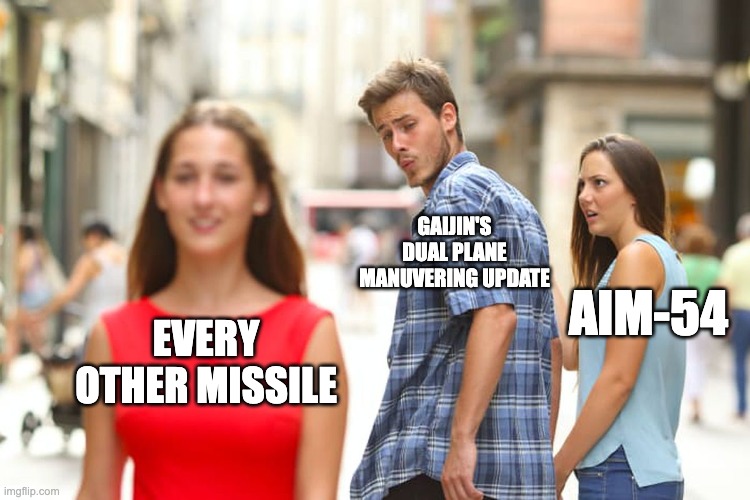Calling it now

Quotes from F-14A Tomcat RIO:
“Sorry for the delay in responding. Although I never fired the AIM-54 in an exercise (I did launch them in a normal mode) it did have an ACM mode that gave it an active launch and higher maneuverability. So in effect it was like an AMRAAM.”
"Again we were at Top Gun over the desert doing gun defense maneuvers. When we got back to base and they checked the G meter it was pegged at 11.0. My pilot, Sluggo, complained of a bad back for a few days. They had to fly a new plane out from Oceana for us in Miramar. "
Can yall imagine if we had the biblically accurate Phoenix ingame?
- Notch tracking perfectly (even with CMs)
- Great Acceleration
- High G maneuverability
- ACM mode
The DCS missile is not well modeled.
I abused the hell of F-14B and AIM-54A MK.60 when it was unnotchable/unchaffable and could fly Mach 4 at sea level in multiplayer. It was always fun to fire at 15 NM using horizontal ACM and then watch the missile (via F6) fly and manouver.
54s in DCS is aren’t that hard for nothing.
I mostly play F-14A in GS server but missed lot of shots.
Also, I really hate Jester.
dcs planes cant pull 13-15g
- looks at the G paddle detent on my F/A-18C
Sustained no, but you can 100% peak at like 12 to 14 in DCS, you just risk causing your wings to implode.
not with normal FCS modes.
Depends on the aircraft just like WT, the 16C is still governed and in WT it cant jack it’s G loading in either title, stuff without FBW, F-14s, F-4s, the Mig-21, and others can all peak at far higher G loading just by ramming the stick back at certain airspeeds, the F-14 in particular used to be able to turn hard enough to cause your engines to implode and break all the instruments in the cockpit, but now the wings fail before such is achievable.
Wouldn’t really matter for the Phoenix in WT unless it’s sustained for a long time. Which isn’t possible.
In what way?
Thrust, burn time, weights, warhead, seeker, it is all based on old data and hasn’t been updated in quite some time. The maximum overload is rather high in single plane and it doesn’t fly solely in either single or dual plane, it can just pitch with max G in any direction which is unrealistic. In real life it would need to roll first, and it would have trouble in the case of the AIM-54A at tracking non head-on or smaller targets against background clutter.
Would the range gate not fix this?
In the case of small cruise missiles flying at very low altitudes over land, probably not. Against maneuvering targets at low altitude, probably not. The seeker was unchanged from like 1963 to 1973 when it entered service. The 1980s AIM-54C seeker was a vast improvement over the original.
From the video we’ve both seen of the Aim-54C rolling to turn in dual plane, it very much looks like in the terminal phase the missile rolls pretty quickly for it’s size and doesn’t really stop oscillating the roll to anticipate the need for a high G maneuver.
7:27
Sure, the slight delay in maneuvering maybe not be modeled, but realistically, how would it be? It’s much too variable to be viable to model.
It’s possible for that specific case in the video that the AWG-9 was still illuminating the J-11 for the Phoenix for periodic updates.
From the “an outsider’s perspective” document we know that The -54A can manage to hit a BQM-34 traveling at Mach .75 at 50ft, from 10,000ft from a range of 22 Nmi at launch. over water (Figure 7).
It’s not like WT can, or should model differing surface return so it’s proof enough that it’s got some sort of filtering going on.
The plane did a simple 6G maneuver per the testing parameters and it is also the updated AIM-54C, so the delay would be longer on the AIM-54A and the AoA limits lower as well due to these delays (because oscillations could not be quickly reduced on the older hardware).
It doesn’t matter if the receiver is having a hard time picking up the HPRF signal in beam aspects or other issues.
Many times targets like this would be lost to the missile and it would still pass within distance of the proxy fuse (which is a massive range on the Phoenix) and it would detonate, any subsequent shrapnel hit would count as a kill for the test.
Of course it has some filtering, but they should really separate the AIM-54A and C by seeker performance. The AIM-54C and all other active fox-3’s should have considerably better seeker performance than they do in-game.
Would the warhead detonating not still kill an aircraft, and at some point the filtering was enough to satisfy guidance constraints to launch the missile, sure we don’t know which mode the AIM-54 was launched in so there is less we can draw from the potential for a SARH / “Command” guided methods.
It still worked though

